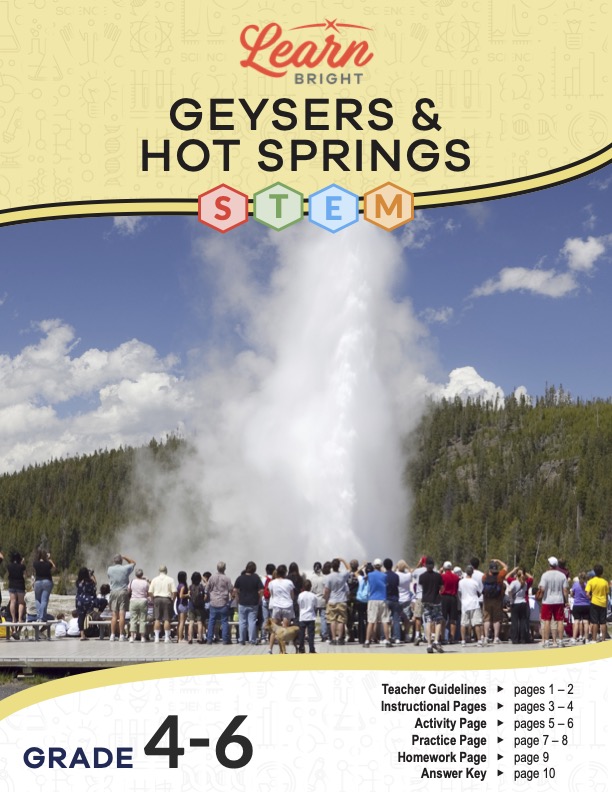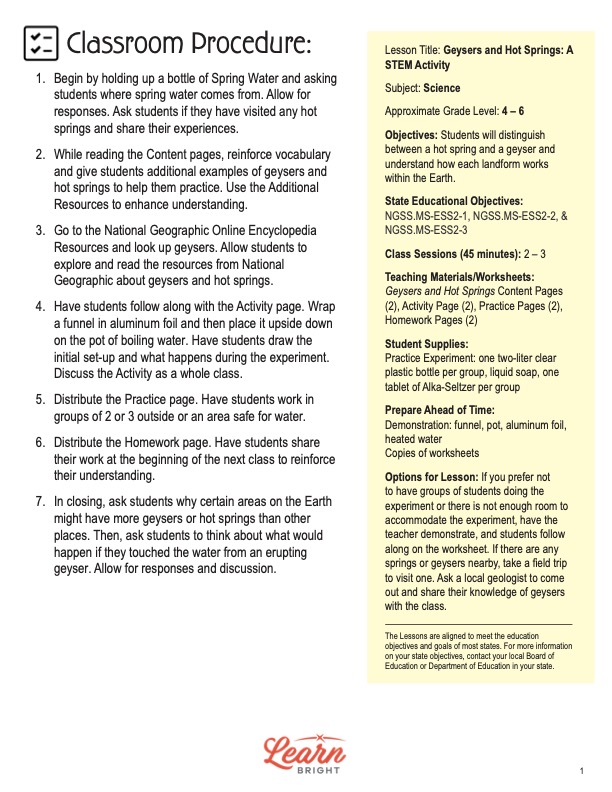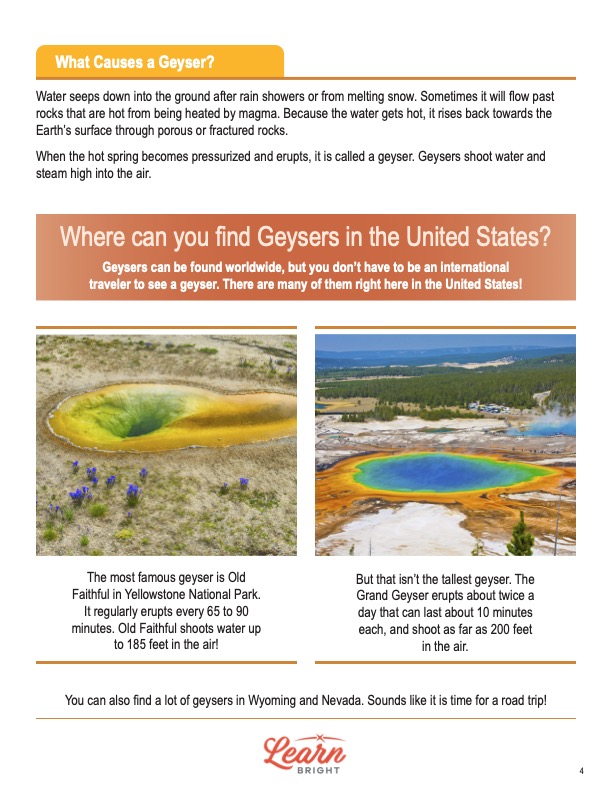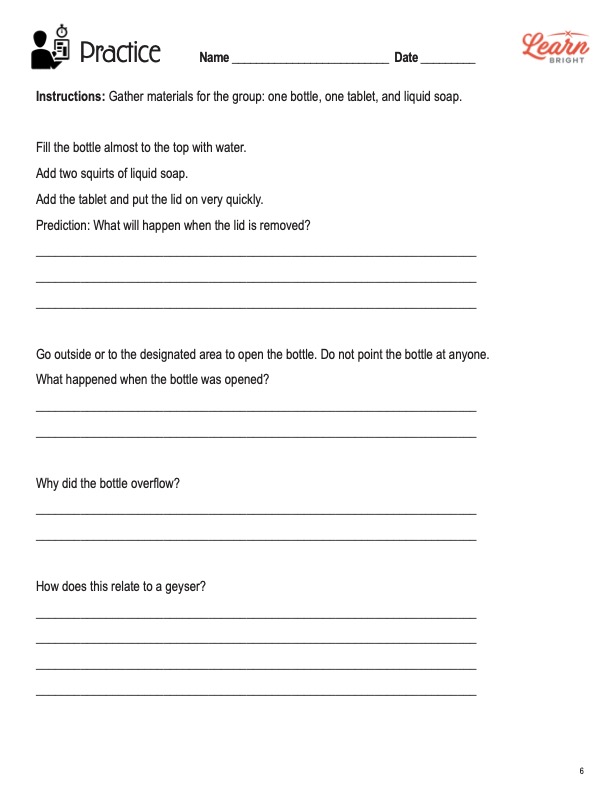Description
What our Geysers and Hot Springs STEM lesson plan includes
Lesson Objectives and Overview: Geysers and Hot Springs STEM explores the traits of each of these natural landforms. Students will learn to differentiate between the two and explain their characteristics. They will also explore how steam builds up underground and how pressure causes a geyser to erupt. This lesson is for students in 4th grade, 5th grade, and 6th grade.
Classroom Procedure
Every lesson plan provides you with a classroom procedure page that outlines a step-by-step guide to follow. You do not have to follow the guide exactly. The guide helps you organize the lesson and details when to hand out worksheets. It also lists information in the yellow box that you might find useful. You will find the lesson objectives, state standards, and number of class sessions the lesson should take to complete in this area. In addition, it describes the supplies you will need as well as what and how you need to prepare beforehand.
Options for Lesson
In the “Options for Lesson” section of the classroom procedure page, you will see some suggestions for additional activities or ideas to add to the lesson if you want to. One idea is to demonstrate the experiment for the whole class rather than dividing them in groups. This would also be a good idea if there isn’t enough room to accommodate the experiment for multiple groups. If you live in a place where there are springs or geysers nearby, consider taking a field trip to visit one with the students. One more idea is to ask a local geologist to speak with the class and answer their questions.
Teacher Notes
The paragraph on this page gives you a little more information on the lesson overall and describes what you may want to focus your teaching on. It explains that this lesson is designed to engage students as they learn about these unique landforms. The blank lines are available for you to write out any thoughts or ideas you have as you prepare.
GEYSERS AND HOT SPRINGS STEM LESSON PLAN CONTENT PAGES
Difference between Geyser and Hot Spring
The Geysers and Hot Springs STEM lesson plan has two content pages. To start off, students will learn what the difference is between the two. Places where groundwater creates a pool of water are springs. Hot springs are pockets of water that are hotter than the surrounding ground and air temperatures. The water in a hot spring is usually higher than 98°F when it comes out of the ground.
This happens because the water is heated from the energy created by the earth. There are around 40 or 50 places on the planet where magma gets close enough to the surface to heat the water below. Sometimes the water mixes with soil and makes hot mud pots.
Some hot springs, also called geothermal or thermal springs, turn into geysers. The geyser comes from the Icelandic word meaning to gush. A geyser is a specific type of landform that has a narrow opening. Geysers repeatedly spew water and then steam, and they are found in places with a lot of geothermal activity.
Causes of Geysers
The next page describe what things cause geysers to form. Water seeps down into the ground after rain showers or from melting snow. Sometimes it flows past rocks that are hot from the heat of magma. Because the water gets hot, it rises back toward the earth’s surface through porous or fractured rocks.
When a hot spring becomes pressurized and erupts, it becomes a geyser. Geysers specifically shoot water and steam high into the air, unlike normal hot springs. Students will learn that these landforms exist all over the world. Many of them are in the United States. Old Faithful in Yellowstone National Park is one of the most famous geysers. It shoots water up to 185 feet in the air every 65 to 90 minutes.
But Old Faithful isn’t the “tallest” geyser. The Grand Geyser is another famous landform of its type that erupts about twice a day. The eruptions can last up to 10 minutes. It shoots water as high as 200 feet in the air. Nevada and Wyoming are home to many geysers in the states.
GEYSERS AND HOT SPRINGS STEM LESSON PLAN WORKSHEETS
The Geysers and Hot Springs STEM lesson plan includes three worksheets: an activity worksheet, a practice worksheet, and a homework assignment. These worksheets will help students demonstrate what they learned throughout the lesson and reinforce the lesson concepts. The guide on the classroom procedure page outlines when to hand out each worksheet to your students.
GEYSER SIMULATION ACTIVITY WORKSHEET
Students will have the opportunity to simulate a geyser for the activity using a number of supplies and materials. First, they will fill a pot with water and place it on a stove or other heat source. Next, they will place the funnel upside down in the pot, leaving enough space for the top of the spout to be above the water line.
Then students will cover the pot with tin foil but poke a hole for the spout to come through. Now they can turn on the heat and wait for the water to boil. The worksheet provides a warning to be careful of the steam coming out of the spout. Make sure students remain far enough away to avoid getting hurt.
At this point, students will draw a picture of what they think is happening in the pan and through the funnel. Based on that drawing, they will draw a picture of how a geyser works. Finally, students will respond to the prompt at the bottom of the page about the similarities between geysers and the experiment.
BOTTLE EXPERIMENT PRACTICE WORKSHEET
For the practice worksheet, students will work in groups to conduct an experiment using bottles, tablets, and liquid soap. (You may also choose to conduct this experiment for the whole class.) They will begin by filling up the bottle almost to the top with water. Then they must add two squirts of liquid soap and the tablet, followed immediately by putting on the lid quickly. They will then explain what they predict will happen when they remove the lid.
Take the students outside to a designated area to open the bottles. Ensure the bottles are not pointing at anyone. After the end of the experiment and once everyone is back inside, students will respond to the other three prompts on the page.
GEYSERS AND HOT SPRINGS STEM HOMEWORK ASSIGNMENT
The homework assignment requires students to imagine a scenario where they are a famous explorer and scientist from 1807. They have been hired to explore the West and verify rumors about something called a geyser. They stumble upon one during their quest, but they have no modern technology to document it. They must write a letter to the newspaper back home describing what they experienced.
Worksheet Answer Keys
The lesson document provides answer keys for the practice and homework worksheets. All the correct answers are in red to make it easy to compare them to students’ responses. Students’ answers for the practice worksheet should mirror those on the answer key fairly closely except for the prediction prompt. (Because of the nature of the homework assignment, answers will vary and no correct answers are provided.) If you choose to administer the lesson pages to your students via PDF, you will need to save a new file that omits these pages. Otherwise, you can simply print out the applicable pages and keep these as reference for yourself when grading assignments.










